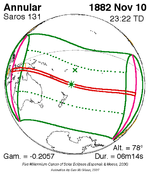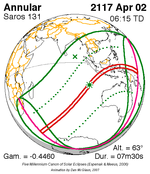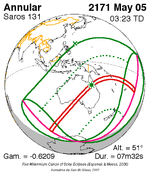An annular solar eclipse occurred on January 15–16, 1991. A solar eclipse occurs when the Moon passes between Earth and the Sun, thereby totally or partly obscuring the image of the Sun for a viewer on Earth. An annular solar eclipse occurs when the Moon's apparent diameter is smaller than the Sun's, blocking most of the Sun's light and causing the Sun to look like an annulus (ring). An annular eclipse appears as a partial eclipse over a region of the Earth thousands of kilometres wide. Annularity was visible in southwestern Western Australia, Tasmania, New Zealand and French Polynesia. It was visible over Australia as a partial solar eclipse at sunrise on January 16. [1] [2] [3] [4] [5] [6] [7] [8] [9] [10]
YouTube Encyclopedic
-
1/3Views:18 42962 5872 949 704
-
Rare annular solar eclipse watched worldwide
-
Jill Goldstein Collection on Letterman, 1991
-
Top 10 Scary SIGNALS From Parallel Universes
Transcription
Images
Related eclipses
Eclipses of 1991
- An annular solar eclipse on January 15.
- A penumbral lunar eclipse on January 30.
- A penumbral lunar eclipse on June 27.
- A total solar eclipse on July 11.
- A penumbral lunar eclipse on July 26.
- A partial lunar eclipse on December 21.
Solar eclipses of 1990–1992
This eclipse is a member of a semester series. An eclipse in a semester series of solar eclipses repeats approximately every 177 days and 4 hours (a semester) at alternating nodes of the Moon's orbit.[11] This semester series contains only 7 eclipses.
| Solar eclipse series sets from 1990–1992 | ||||||
|---|---|---|---|---|---|---|
| Ascending node | Descending node | |||||
| Saros | Map | Gamma | Saros | Map | Gamma | |
| 111 | 1989 February 6 | −1.56550 | 116 | 1989 August 1 | 1.58396 | |
| 121 | 1990 January 26 Annular |
−0.94571 | 126 | 1990 July 22 Total |
0.75972 | |
| 131 | 1991 January 15 Annular |
−0.27275 | 136 From Playas del Coco |
1991 July 11 Total |
−0.00412 | |
| 141 | 1992 January 4 Annular |
0.40908 | 146 | 1992 June 30 Total |
−0.75120 | |
| 151 | 1992 December 24 Partial |
1.07106 | 156 | 1993 June 20 | −1.56439 | |
Saros 131
It is a part of Saros cycle 131, repeating every 18 years, 11 days, containing 70 events. The series started with partial solar eclipse on August 1, 1125. It contains total eclipses from March 27, 1522 through May 30, 1612 and hybrid eclipses from June 10, 1630 through July 24, 1702, and annular eclipses from August 4, 1720 through June 18, 2243. The series ends at member 70 as a partial eclipse on September 2, 2369. The longest duration of totality was only 58 seconds on May 30, 1612. All eclipses in this series occurs at the Moon’s ascending node.
| Series members 33–70 occur between 1702 and 2369 | ||
|---|---|---|
| 33 | 34 | 35 |
 July 24, 1702 |
 August 4, 1720 |
 August 15, 1738 |
| 36 | 37 | 38 |
 August 25, 1756 |
 September 6, 1774 |
 September 16, 1792 |
| 39 | 40 | 41 |
 September 28, 1810 |
 October 9, 1828 |
 October 20, 1846 |
| 42 | 43 | 44 |
 October 30, 1864 |
 November 10, 1882 |
 November 22, 1900 |
| 45 | 46 | 47 |
 December 3, 1918 |
 December 13, 1936 |
 December 25, 1954 |
| 48 | 49 | 50 |
 January 4, 1973 |
 January 15, 1991 |
 January 26, 2009 |
| 51 | 52 | 53 |
 February 6, 2027 |
 February 16, 2045 |
 February 28, 2063 |
| 54 | 55 | 56 |
 March 10, 2081 |
 March 21, 2099 |
 April 2, 2117 |
| 57 | 58 | 59 |
 April 13, 2135 |
 April 23, 2153 |
 May 5, 2171 |
| 60 | 61 | 62 |
 May 15, 2189 |
 May 27, 2207 |
 June 6, 2225 |
| 63 | 64 | 65 |
 June 18, 2243 |
 June 28, 2261 |
 July 9, 2279 |
| 66 | 67 | 68 |
 July 20, 2297 |
 August 1, 2315 |
 August 11, 2333 |
| 69 | 70 | |
 August 22, 2351 |
 September 2, 2369 | |
Tritos series
This eclipse is a part of a tritos cycle, repeating at alternating nodes every 135 synodic months (≈ 3986.63 days, or 11 years minus 1 month). Their appearance and longitude are irregular due to a lack of synchronization with the anomalistic month (period of perigee), but groupings of 3 tritos cycles (≈ 33 years minus 3 months) come close (≈ 434.044 anomalistic months), so eclipses are similar in these groupings.
| Series members between 1901 and 2100 | |||
|---|---|---|---|
 September 21, 1903 (Saros 123) |
 August 21, 1914 (Saros 124) |
 July 20, 1925 (Saros 125) | |
 June 19, 1936 (Saros 126) |
 May 20, 1947 (Saros 127) |
 April 19, 1958 (Saros 128) | |
 March 18, 1969 (Saros 129) |
 February 16, 1980 (Saros 130) |
 January 15, 1991 (Saros 131) | |
 December 14, 2001 (Saros 132) |
 November 13, 2012 (Saros 133) |
 October 14, 2023 (Saros 134) | |
 September 12, 2034 (Saros 135) |
 August 12, 2045 (Saros 136) |
 July 12, 2056 (Saros 137) | |
 June 11, 2067 (Saros 138) |
 May 11, 2078 (Saros 139) |
 April 10, 2089 (Saros 140) | |
 March 10, 2100 (Saros 141) |
|||
Metonic series
The metonic series repeats eclipses every 19 years (6939.69 days), lasting about 5 cycles. Eclipses occur in nearly the same calendar date. In addition, the octon subseries repeats 1/5 of that or every 3.8 years (1387.94 days). All eclipses in this table occur at the Moon's ascending node.
| 21 eclipse events, progressing from south to north between June 10, 1964, and August 21, 2036 | ||||
|---|---|---|---|---|
| June 10–11 | March 27–29 | January 15–16 | November 3 | August 21–22 |
| 117 | 119 | 121 | 123 | 125 |
 June 10, 1964 |
 March 28, 1968 |
 January 16, 1972 |
 November 3, 1975 |
 August 22, 1979 |
| 127 | 129 | 131 | 133 | 135 |
 June 11, 1983 |
 March 29, 1987 |
 January 15, 1991 |
 November 3, 1994 |
 August 22, 1998 |
| 137 | 139 | 141 | 143 | 145 |
 June 10, 2002 |
 March 29, 2006 |
 January 15, 2010 |
 November 3, 2013 |
 August 21, 2017 |
| 147 | 149 | 151 | 153 | 155 |
 June 10, 2021 |
 March 29, 2025 |
 January 14, 2029 |
 November 3, 2032 |
 August 21, 2036 |
Notes
- ^ "Hoy, eclipse anular de sol y luna nueva". El Nuevo Herald. Miami, Florida. 1991-01-15. p. 19. Retrieved 2023-10-18 – via Newspapers.com.
- ^ "Marshfield area weather". Marshfield News-Herald. Marshfield, Wisconsin. 1991-01-15. p. 16. Retrieved 2023-10-18 – via Newspapers.com.
- ^ "AstroData". The Morning Call. Allentown, Pennsylvania. 1991-01-15. p. 16. Retrieved 2023-10-18 – via Newspapers.com.
- ^ "'Serious' Southland quake predicted". The Modesto Bee. Modesto, California. 1991-01-15. p. 16. Retrieved 2023-10-18 – via Newspapers.com.
- ^ "Dread as eclipse blots out the sun". Birmingham Evening Mail. Birmingham, West Midlands, England. 1991-01-16. p. 8. Retrieved 2023-10-18 – via Newspapers.com.
- ^ "Eye protection essential to watch solar eclipse". The Sydney Morning Herald. Sydney, New South Wales, New South Wales, Australia. 1991-01-16. p. 8. Retrieved 2023-10-18 – via Newspapers.com.
- ^ "Solar eclipse ominous sign". Star-Phoenix. Saskatoon, Saskatchewan, Canada. 1991-01-16. p. 1. Retrieved 2023-10-18 – via Newspapers.com.
- ^ "Eclipse further darkens mood in New Zealand". The Sault Star. Sault St. Marie, Ontario, Canada. 1991-01-16. p. 18. Retrieved 2023-10-18 – via Newspapers.com.
- ^ "Kiwis view ancient omen of doom". Edmonton Journal. Edmonton, Alberta, Canada. 1991-01-16. p. 5. Retrieved 2023-10-18 – via Newspapers.com.
- ^ "Visitor's Sydney". The Sydney Morning Herald. Sydney, New South Wales, New South Wales, Australia. 1991-01-16. p. 18. Retrieved 2023-10-18 – via Newspapers.com.
- ^ van Gent, R.H. "Solar- and Lunar-Eclipse Predictions from Antiquity to the Present". A Catalogue of Eclipse Cycles. Utrecht University. Retrieved 6 October 2018.
References
- Earth visibility chart and eclipse statistics Eclipse Predictions by Fred Espenak, NASA/GSFC





